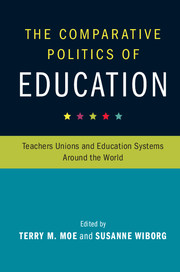Book contents
- Frontmatter
- Contents
- List of Contributors
- 1 Introduction
- 2 Teachers Unions in the United States: The Politics of Blocking
- 3 Teacher Unions in England: The End is Nigh?
- 4 Teacher Unionism in France: Making Fundamental Reform an Impossible Quest?
- 5 Teacher Unionism in Germany: Fragmented Competitors
- 6 Teachers Unions in the Nordic Countries: Solidarity and the Politics of Self- Interest
- 7 Teachers' Unions in Japan: The Frustration of Permanent Opposition
- 8 Teachers' Unions in Mexico: The Politics of Patronage
- 9 Teacher Unions in India: Diverse and Powerful
- 10 The Comparative Politics of Education: Teachers Unions and Education Systems Around the World
- Index
- References
3 - Teacher Unions in England: The End is Nigh?
Published online by Cambridge University Press: 22 December 2016
- Frontmatter
- Contents
- List of Contributors
- 1 Introduction
- 2 Teachers Unions in the United States: The Politics of Blocking
- 3 Teacher Unions in England: The End is Nigh?
- 4 Teacher Unionism in France: Making Fundamental Reform an Impossible Quest?
- 5 Teacher Unionism in Germany: Fragmented Competitors
- 6 Teachers Unions in the Nordic Countries: Solidarity and the Politics of Self- Interest
- 7 Teachers' Unions in Japan: The Frustration of Permanent Opposition
- 8 Teachers' Unions in Mexico: The Politics of Patronage
- 9 Teacher Unions in India: Diverse and Powerful
- 10 The Comparative Politics of Education: Teachers Unions and Education Systems Around the World
- Index
- References
Summary
Introduction
In striking contrast to organised teachers in Europe and the USA, the teacher unions in England have had a substantial amount of power removed from them during the last 30 years. Their power was brutally cut by Margaret Thatcher during her long premiership from 1979 to 1990, a blow from which the unions have never recovered. They lost access to policy formulation and their national bargaining rights were abolished. Prior to Thatcher, the teacher unions were an influential force in education politics, reaching their zenith of power in the 1960s and 1970s. The ‘iron triangle’ between organised teachers, local authorities and central government, which were in full operation throughout these two decades, enabled teacher unions to become intimately involved in education policy at both national and local levels. Their powerbase was primarily concentrated at a local level, given that local authorities have been responsible for the planning and provision of education since 1944. Following Margaret Thatcher's arrival, a raft of policies were introduced to dismantle this ‘iron triangle’ and in its place the government launched a system which was, on the one hand, governed by a centralisation of power and, on the other hand, marketisation of education. Central government would thus control the framework within which schools would compete with one another for resources, teachers and students, and thus by extension, higher standards.
This substantial reorganisation of English education is significant and has been subjected to a large number of studies seeking to understand why and how this change was brought about, along with its long-term effects. The dominant explanation provided by this literature is the political will of Margaret Thatcher and her forceful education secretaries, most notably Kenneth Baker; the reinvention of Victorian laissez-faire individualism; and the spreading of global neo-liberal ideology and austerity which were crucial in pushing through reforms (Ball 1990, 2008; Chitty 2004; Simon 1991; Tomlinson 2005; Whitty 1989, 2008).
However, the existing academic writing fails to add any analytical value to the fact that the curbing of vested interests opposing change resulted for the most part in rapid policy implementation. The Conservative government undermined the key institutional structure within which the teacher unions were closely integrated: the local authorities. This simply opened the gates for radical reform.
- Type
- Chapter
- Information
- The Comparative Politics of EducationTeachers Unions and Education Systems around the World, pp. 56 - 86Publisher: Cambridge University PressPrint publication year: 2016
References
- 6
- Cited by

